On Course for the Cloud
According to the IDC report (“IDC MarketScape: Worldwide Integrated Talent management 2012 Vendor Analysis”), SuccessFactors is a leader in HCM solutions, whose strengths include above all: amarket position, innovation and dynamic growth. HCM SaaS solutions are rapidly conquering the market. According to Gartner (Impact of Cloud Computing on Human Capital Management Applications – October 2011), in 2015 they will make up 70% of HCM applications sold. The same report points out that the expansion of talent management solutions is taking place right now.
SAP’s strategic decision to buy SF, or the acquisition of Taleo by Oracle, are something more than just the addition of another product to their portfolio – the major suppliers of ERP systems increasingly opt for SaaS. According to the companies carrying out IT market research for many years (Gartner, IDC, Forrester), the advantages of cloud solutions include low cost, lack of involvement of IT resources, innovation, continuous development, and finally, rapid implementation.
In August this year, SNP Poland (BCC until 2017) and SuccessFactors signed a partnership agreement. Under this agreement, SNP expands its SAP HR (SAP HCM) offering to include HR cloud services relating, in particular, to soft HR.
SNP is one of the first SAP partners in Poland that concluded the partnership agreement with SuccessFactors. “The agreement with SNP is a logical consequence of our strategy, which provides for the cooperation in a specific market with companies with the greatest experience and potential in the field of HR solutions.” – says Dr. Martin Stawowiak, Director, Sales Partner & Alliances Central Europe at SuccessFactors.
SuccessFactors offers the BizX (Business Execution) solution that supports enterprises in acquiring and motivating talents, and in human capital planning, which should ultimately translate into competitiveness and measurable business results.
An important part of the SuccessFactors BizX Suite is Employee Central that contains the basic personal and organizational data on employees used by other applications. This database will be fed with the data from SAP HR, if one is used in the company. It also serves as a source of information for BizX self-service functions.
The key applications of the BizX Suite include:
- Compensation – supports a “pay for performance" culture, in particular, the pay management which promotes the best people and rewards employees fairly
- Goal and performance management – helps align company business objectives with measurable goals for employees, supports reviews and assessments, and makes it easier for employees to understand the company strategy
- Succession and development – helps companies prepare for a shortage of successors for key positions, and supports them in career planning and bridging competence gaps
- Workforce planning – provides a series of tools for employment planning, helps you answer “what if” questions, and allows you to simulate the consequences of business decisions and their impact on workforce demand
- Workforce analytics – aligns talent information with business data, allows you to find reasons for negative and positive effects, and to analyze trends
- JAM – based on the idea of social networks, it improves internal communication within the company, and makes it easier to share knowledge and create training materials
- Recruiting – incorporates recruitment processes into the company’s talent management strategy, supports all stages of the acquisition of new employees, including marketing, which makes the company attractive to outsiders and motivates them to establish a relationship
- Training management – helps develop a training strategy in a company, in particular, to manage instructor-led, electronic and mixed training courses, and create teaching materials.
Saratoga Institute: 84% of companies do not take advantage of the full potential of their employees
Corporate Strategy Board Research / Measures that Matter: 50% of employee potential is wasted on ineffective tasks.
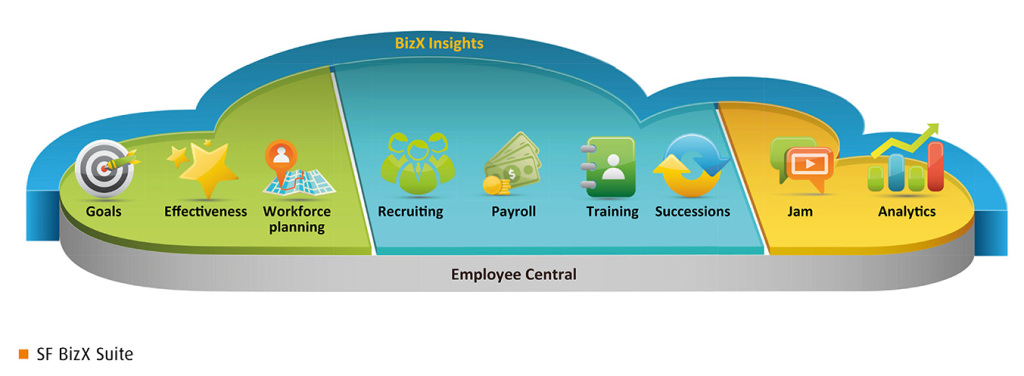
SF BizX Suite
Compensation
Compensation planning, based only on tools such as spreadsheets or e-mail, is ineffective and prone to error, not to mention confidentiality. Decision-makers need to be supported by an integrated system (including talent management) which will help them identify top-performing and outstanding employees, as well as those who are underachieving. The remuneration policy should reward the best.
The SF Compensation solution allows you to align compensation, which is often the biggest expense of the organization, with the company’s business results.The application supports the entire compensation planning process and all its participants – from planners and managers through to employees – who may view the results of their work in a self-service mode.
Key features of the application:
- Support for planning all compensation components (basic pay, bonuses, awards, etc.)
- Intuitive and configurable workflow
- Alignment of goals and their achievement with salaries
- Comparison of the pay and performance of individual employees
- Modeling, distribution, and control of budgets
- Ability to model automatic compensation changes (e.g. based on pay-scales, assessment results, realization of a plan, or other corporate guidelines)
- Various pay and bonus programs.
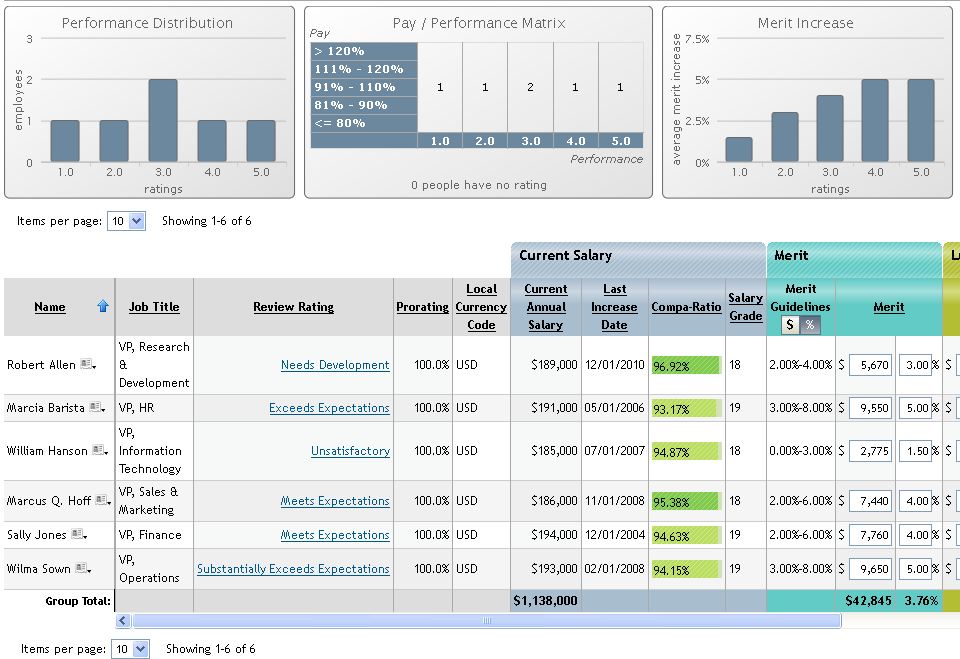
Compensation planning analytics
Goal and Performance Management
The SF goal and performance management solution has been recognized as an industry-leading HCM solution in the Gartner report (Gartner, 2011 Magic Quadrant for Employee Performance Management Software).Company goals should be clear to the employee, and what’s more – they should be translated into specific objectives for a particular position. The organization’s strategy should be aligned with the activity of employees and their performance should be monitored to provide them with feedback and coaching. Here’s what the innovative approach of SF is:
- Customers have access to a library of more than 500 recommendations for goals that meet the SMART (Specific, Measurable, Attainable, Realistic, and Timely) requirement
- Managers monitor the achievement of goals from different perspectives: department, team, and individuals
- A built-in scanning application supports managers in ensuring that their actions (in particular review and assessment results) are consistent with the SOX Act
- Employee-friendly interface of periodic reviews and assessments
- Integration with MS Outlook – sending reminder e-mails to people engaged in reviews and assessments
- A unique tool for employee assessment of the team to minimize the risk of unfair treatment
- Alignment of goals and their achievement with the compensation system to promote top-performers
- Easy identification of top-performing employees
- Automatic advisor to help managers in coaching their subordinates
- Ranking of employees with an indication of candidates for leaders.
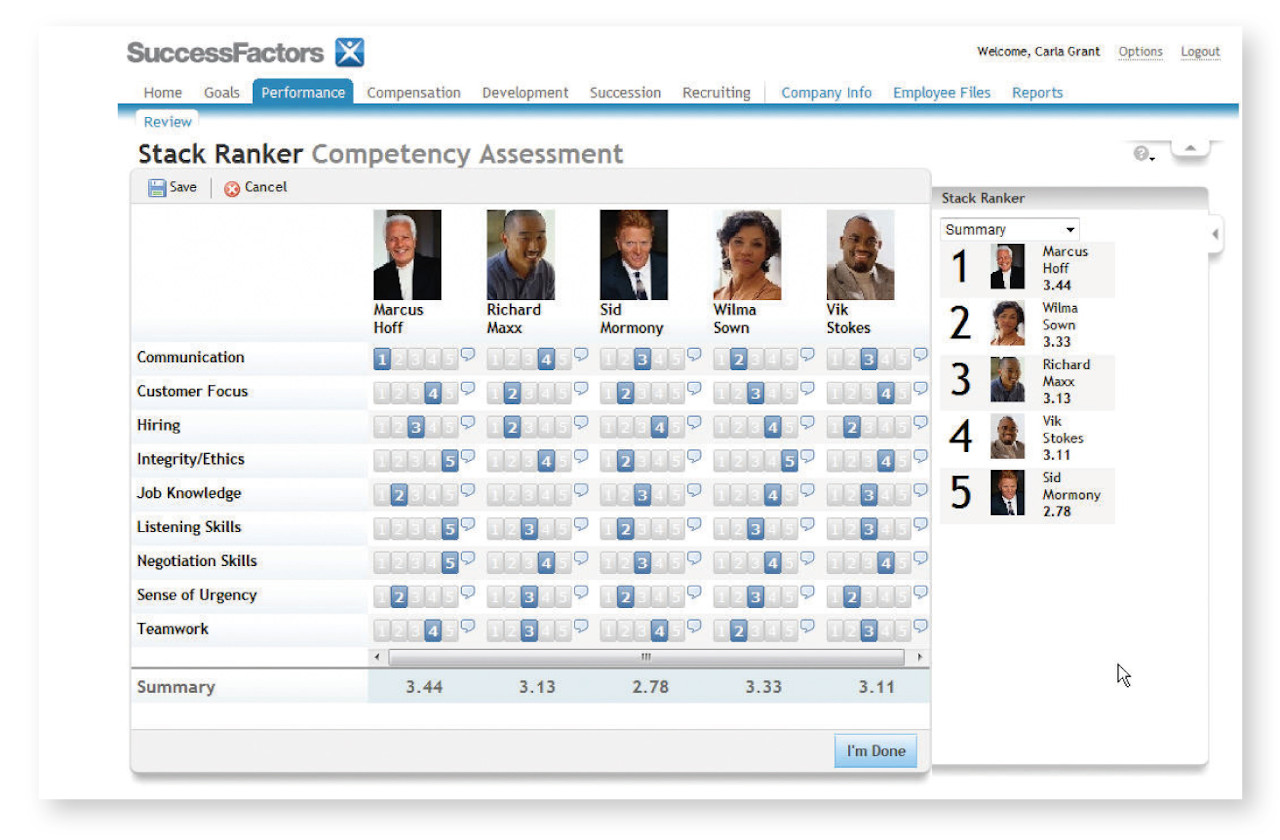
Overview of team competence and looking for top-performers
Succession and Development
The unexpected departure of a key employee leads to a number of negative consequences for the organization, such as the lack of a leader, lost profits, or cost of finding a successor.On the other hand, the company may have employees in roles in which their talent is not fully used, or the requirements are not aligned with competencies. Organizations should make every effort to have the right people in the right place.
The SF solution helps managers identify competence gaps and predict talent shortages in the organization. In particular, the application supports them in defining the succession and development plans for key positions:
- Managers get to know the skills, capabilities, performance and preferences of their subordinates
- SF allows for the identification of current and potential competence gaps with an evaluation of the impact of talent shortage on business activity
- Managers can search the organization’s talent database and find the best substitutes
- The application suggests development activities for people with identified competence gaps
- The analysis of a domino effect allows employees to prepare for the implementation of a succession plan for senior positions.
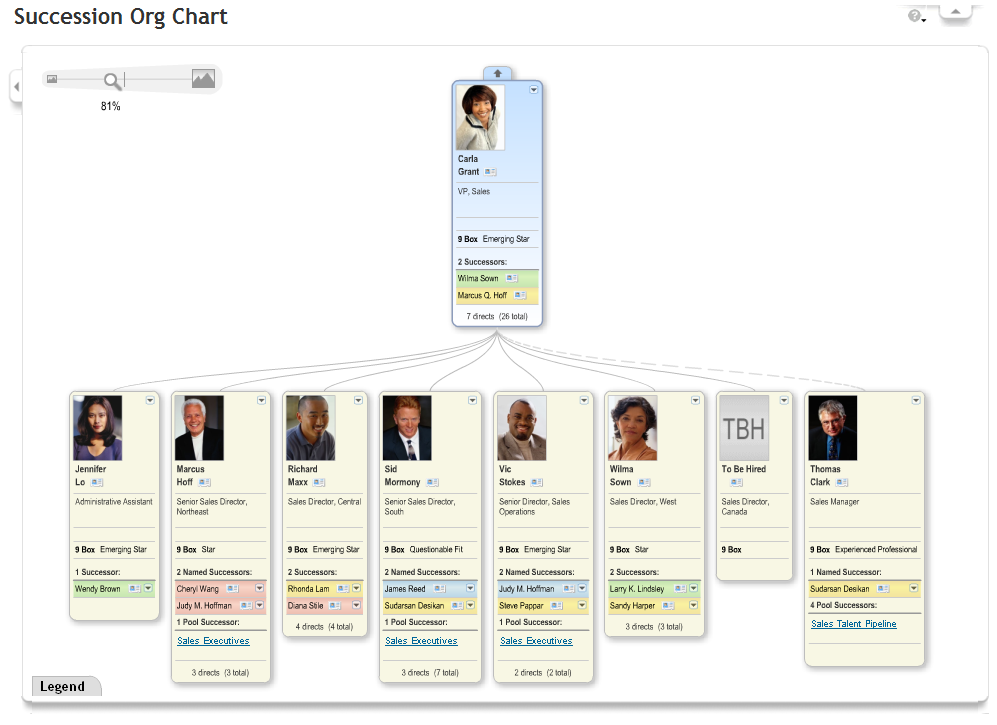
Succession structure
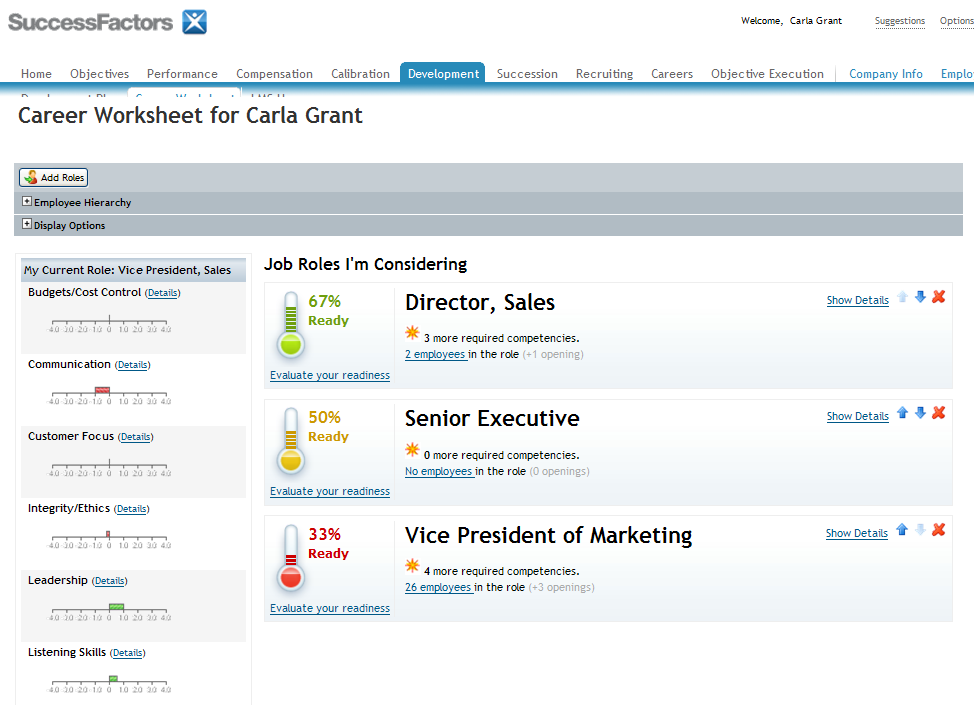
Employee career worksheet
Workforce Planning
Organizations that make long-term plans want to know what and how many employees they will need in the next 3 to 5 years if the current strategy is implemented.Staffing needs may result from planned growth, acquisitions and mergers, decisions to enter new markets, and the development of new products. By using the SF solution, organizations can carry out complex analyses of the consequences of future strategic decisions, and in particular:
- Estimate the financial effects of future staffing changes
- Plan staffing needs resulting from the adopted growth strategy
- Dynamically model organizational changes and their financial implications
- Manage risks through the identification of workforce shortages and competence gaps needed to support the growth strategy
- Optimize the results of changes by analyzing different ‘what if’ scenarios for changes in the workforce.
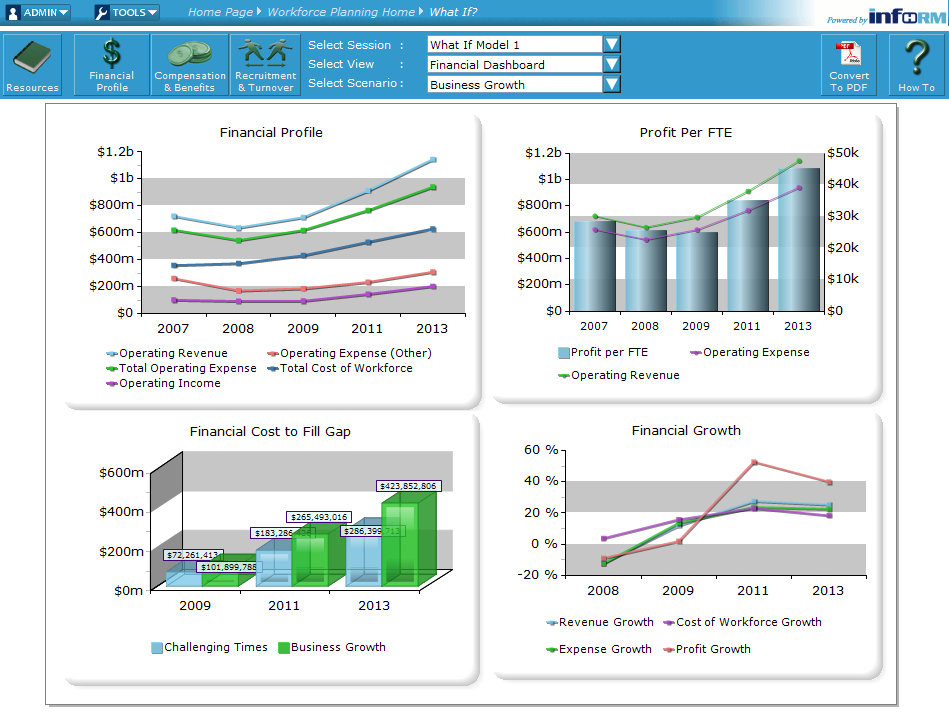
‘What if’ scenario analysis
Workforce analytics
The analytics system provided by SF allows you to find answers to key questions about your staff, ranging from the simplest, “What is the current headcount?” through to more difficult questions, such as:
- What is the profit per employee? Is it growing? What does it look like compared to our competitors?
- Which of the organizational units are performing best (percentage of goal realization) and why?
- What is the staff turnover and how does it influence the realization of the company’s strategic goals?
The added value of the application is its capability to compare our data with available information on other companies – SF customers who are willing to share their knowledge.Users will also find a report wizard and a set of standard evaluations – over 100 critical questions about HR with functions for root cause and trend analysis.
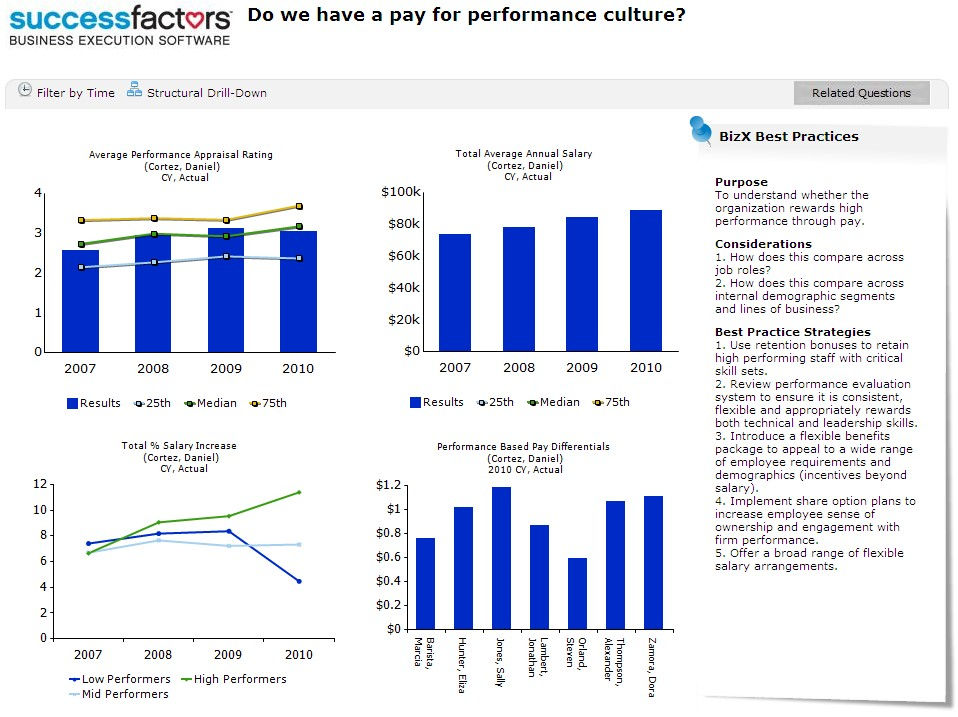
JAM
In HR applications, SF incorporates solutions tested in social networks such as Facebook or YouTube, assuming that every organization has experts whose knowledge you sometimes need to use on an ad hoc basis.
JAM helps you find and communicate with them.With a few mouse-clicks, you can record a video instruction and make it available to other users.JAM allows you to quickly exchange documents, files, images and videos, and to get answers to your questions. It is just an internal social network. Some of its most interesting applications include:automatic addition of new employees to the “I start working” newsgroup, and creation of groups to exchange information between training participants and instructors.
Recruiting
Recruitment tools are no longer a novelty – the majority of companies use recruitment solutions.SF offers not only automation of recruitment processes, but also allows you to answer very important questions:
- Does the company invest in effective recruitment media?
- What are the areas in our organization with the greatest number of vacancies?
- What is the percentage of vacant key positions?
- How efficient are the recruitment recommendations of our employees?
The SF solution was intended to be easy to use, social and mobile. This has been achieved through:
- Simplification of candidate registration (one-page form)
- A simplified feedback management process for candidates
- Integration with JAM (discussions on candidates among recruiters)
- Integration with social media such as LinkedIn, Facebook and Twitter
- Shorter waiting time for all recruitment-process stakeholders by making it mobile (participation in the process by using smartphones and tablets).
This year, SF has patented the technology, called recruitment marketing, to optimize recruitment sites (increase the site’s visibility on the web and its attractiveness to candidates).
Learning Management
SF Learning Management facilitates the development of the company’s training strategy through:
- Providing access to training courses for each employee
- Providing tests and exams to verify knowledge and certificates
- Managing training courses from a central point
- Enabling mobile learning (“learning-on-the-go" – participation by phone or tablet).
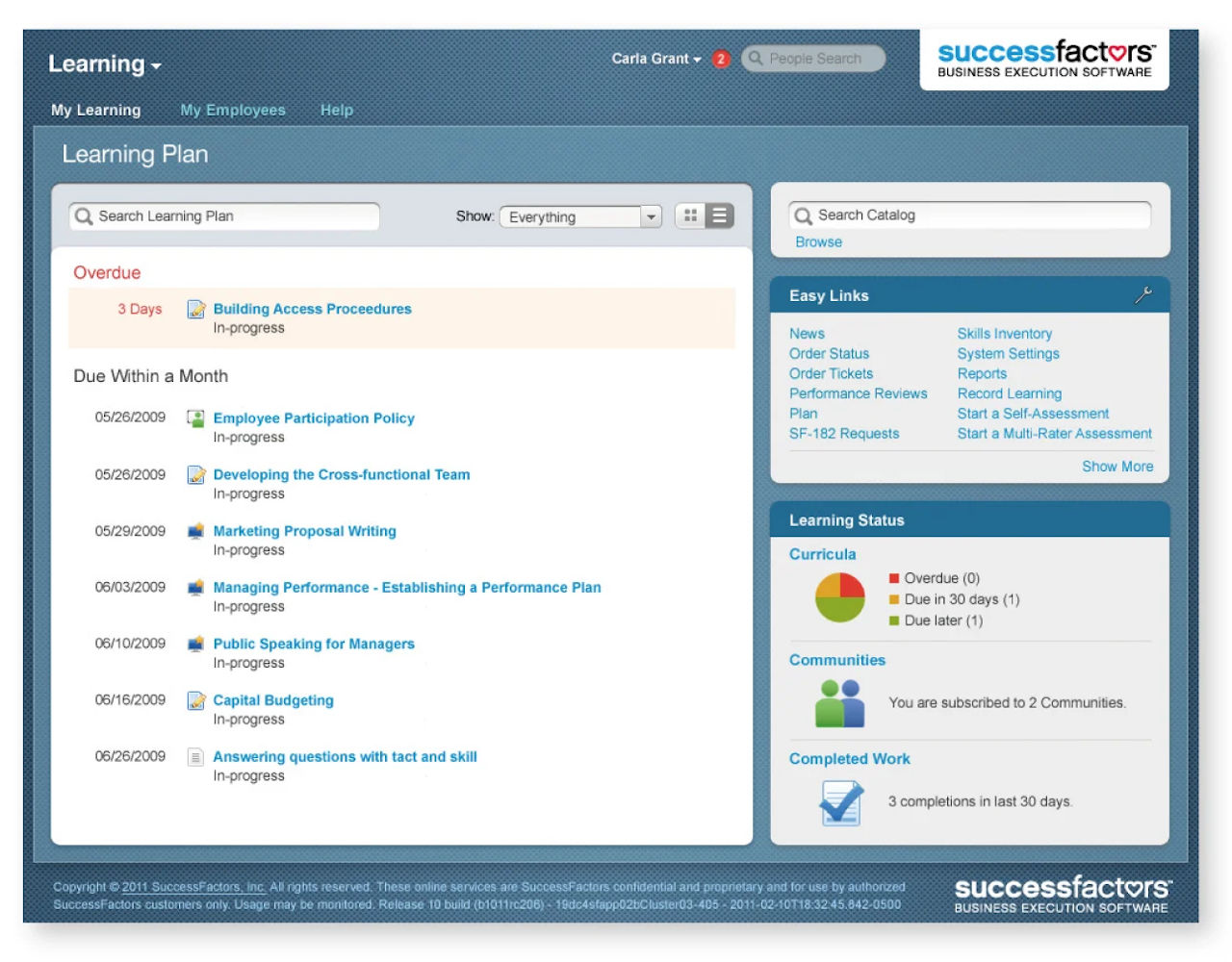
Learning plan
Time for payroll
The next step in collaboration between SAP and SuccessFactors is the cloud-based payroll offering (SAP Cloud Payroll). Today, the SAP payroll solution in this model is available in 10 countries: the USA, Germany, Canada, Brazil, Mexico, Holland, the United Kingdom, Switzerland, India and Australia. SAP Cloud Payroll may be used by customers that are already using SF applications, in particular, Employee Central.
Security in subscription
The SuccessFactors application is written in Java. It generates dynamic pages and sends them to users in an encrypted form, in accordance with SSL. SF customers share the same security network infrastructure, web servers, application servers, and database instances, but each of them have their own set of tables and database partitions containing a unique database schema. Each instance (customer base) can be exported in whole from the database without affecting other customers.
Data privacy is a priority for many customers, so their fears of the transmission and storage of sensitive information (talents, salaries) in the cloud are understandable. Many customers are hesitant to purchase SaaS applications (a more appropriate word would be “subscription") due to a number of concerns regarding the integration, flexibility, and the risk of the implementation project itself, to name a few.
The answer from SF is a secure HCM SaaS solution. Confidentiality is ensured, in particular, through role-based authorizations, encryption and the isolation of customer data at all levels (e.g. AES-256bit encryption in the storage layer, SSL-128bit/256bit encryption in the transport layer) and the data center’s compliance with SSAE 16 and SOC 2 requirements.
Customers are also worried about integration aspects. They often ask the question “will I be able to painlessly connect my applications to the solution in the cloud?" Hybrid and mixed environments consisting of cloud and on-premise systems are becoming commonplace. Organizations should select those SaaS applications that are 100% based on open standards, so that they can be integrated with existing systems easily and relatively cheaply. SF provides SAP HR customers with ready-made bidirectional interfaces (e.g. to download the employee master data to the cloud, or to import the data to payroll in SAP from SF Compensation Management) and an integration platform with pre-configured connections (processes, web services, file interfaces).To sum up, companies can develop the dedicated connections to their applications regardless of the pre-configured interface package.
Other doubts are about the configurability of solutions in the cloud. Will the cloud application meet certain customer requirements, and is it configurable? In the case of SF, due to the adopted solution architecture, customers have access to extensive customization features for the user interface, rules and algorithms, workflow, reporting, access control, and permissions. Configuration takes place at two levels: the data model (logic, headers, dictionaries, client fields) and the metadata (client objects, user interfaces, business logic).
In most conversations with customers, an important issue is the duration of the project and the associated risks. SaaS solutions are usually less expensive and can be implemented much faster than traditional application deployments on-site. SF applications are launched, on average, within 3 to 6 months, depending on their scope. The implementation is carried out in accordance with the proven five-phase EMPOWER method used during deployments in over 3,500 organizations.
15 Million Users
With more than 3,500 customers – with the largest number among cloud solutions – SuccessFactors BizX has 15 million users.
Included among SF customers are Siemens, Nestle, Allianz, GM, ING, Deutsche Bank, Societe Generale, Bombardier, P&G, Whirlpool, KRAFT, Nokia Siemens Networks, BP, Coca-Cola, and T-Mobile.
According to a study by McKinsey in 2009 on a sample of 500 of the biggest SF customers, the implementation of SF solutions brought those companies significant business benefits, such as:
- A 15% reduction of staff turnover
- A more than 5% increase in the time spent on prioritized and strategic tasks
- A 14% increase in the number of successful projects
- A 1% increase in the company’s profitability.

